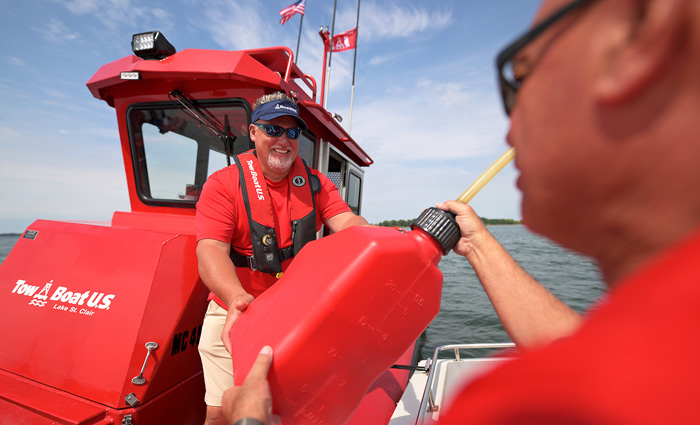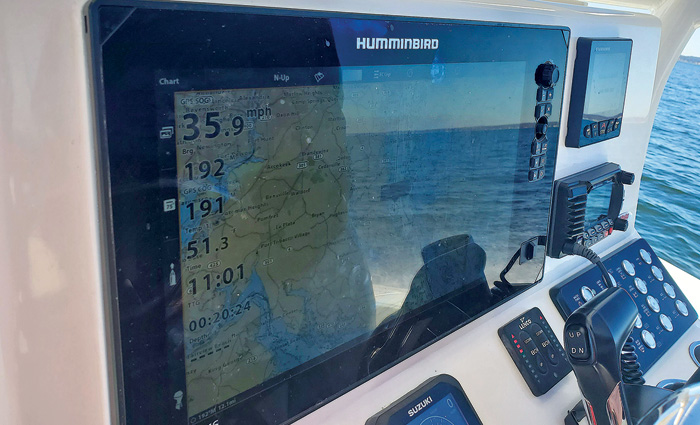Advertisement
Modern boats can be so jammed with tech that it’s easy to miss something that could cause a major failure, leading to danger.

Photo: Jason Arnold/BoatU.S.
Is your new boat so smart it’s fooling you? Considering the level of tech found in many modern powerboats, it’s not nearly as far-fetched as one might think. On today’s boats, anything from a fuel gauge to a fan switch can be digitized, and while this usually results in more reliable and easier-to-use systems, it can also result in mistaken impressions. Be on the lookout for these three common glitches.
1. Running out of fuel
Fuel gauges in boats have been notoriously unreliable for as long as there have been boats that carried fuel. The oddly shaped fuel tanks found in many boats can cause a gauge to sit on full for hours, then race down to empty in minutes. Sloshing while underway can produce readings so uneven they’re useless. And needles can and do get stuck. In fact, fuel gauges on boats are so unreliable that many experienced mariners track their fuel burn and have a good idea of how much fuel is aboard, regardless of what the gauges say.
Digital fuel gauges are a big step up. They can compensate for tanks with odd shapes, dampen the sloshing effect, and don’t have needles in the first place. There’s just one fly in the ointment: They need to be properly calibrated. And not all boatbuilders take the time and effort to do so. Different systems have different calibration processes, which usually involve filling the tank all the way, so there are both knowledge and economic barriers to calibrating the gauge that many builders will simply shrug off. The net result? You may take delivery of a new boat or buy a boat that’s relatively modern and experience the exact same problems – or worse ones – than those old analog gauges created.
If you have a boat with a digital fuel gauge and wonder why it works no better than the old-school variety, search for the calibration instructions online and work through the process. There’s an excellent chance you’ll discover that it works magnificently, and it just needed to “learn” what it was supposed to be telling you.
2. Running aground
Whether you’re a cruiser trying to avoid a grounding or an angler looking for fish, knowing the exact amount of water under your hull can be critical. Luckily, the pings sent out from today’s transducers are highly accurate and virtually foolproof. So why might your depth sounder tell you the water is 4 feet deep when you have a draft of 3 feet and you’re hard aground?
A tricky little setting called the “offset” is a likely culprit. Few transducers are mounted at the lowest point on a hull, and some may be well over a foot higher than the lowest point. The offset, found somewhere in the depth finder’s settings, allows you to “tell” the system that the transducer is “X” higher than the bottom of the boat or lower than the waterline. But there’s nothing automatic about it, and you have to set it in order for it to work. Time to reach for the owner’s manual.

Integrating your VHF with the GPS is as simple as connecting NMEA input and output wires. Photo: Lenny Rudow
3. Calling for help
In 1999, FCC began requiring every VHF radio sold to include digital selective calling, or DSC, functionality. This allows the U.S. Coast Guard to receive your exact GPS coordinates and information about your boat the moment you make a distress call. Yet, to this day, the Coast Guard reports that fewer than half of the recreational boats out there with VHFs are DSC-active. This is a critical safety issue, and if you need to call for help, you certainly don’t want to think you’re covered when you’re not.
The steps to get DSC set up are incredibly simple: First, the VHF needs GPS data. Many modern units have onboard GPS. If not, you need to integrate the VHF with your GPS. “Integrate” might sound imposing, but it requires connecting a couple of NMEA0183 or NMEA2000 output wires from the GPS with a couple of NMEA0183 or NMEA2000 input wires on the VHF. Check your owner’s manual or search the units online and you’ll discover it’s a startlingly simple process.
Next, you need to get an MMSI number. This is as simple as going to BoatUS.com/MMSI and clicking “Obtain a MMSI Number.” Even better, it’s completely free for BoatU.S. members!
Finally, program the MMSI number into your unit. This is another simple process covered in the owner’s manual. It generally consists of nothing more than going into the menu, choosing “Program MMSI,” and carefully keying in the digits.
Modern tech can cause all kinds of headaches. And in these three cases, it could potentially result in utter disaster. But each of these digital dilemmas can be easily avoided with a tiny bit of foresight and a dash of prevention. In the long run, your days of boating will be better for it.
